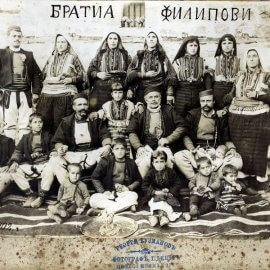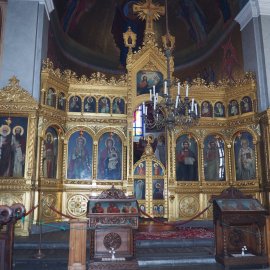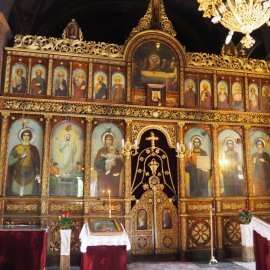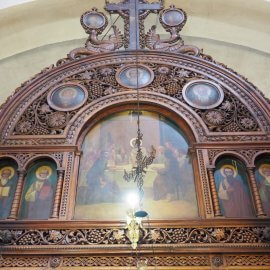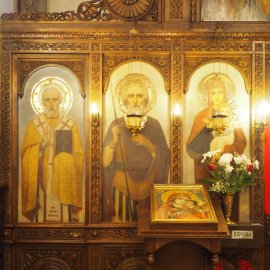Basic information
Born: 1875
Died: 1940
Wood carving in the churches of Sofia
- 1893 – Church of St. Elias the Prophet, Knyazhevo district – bishop’s throne and columbarium above the Holy Throne;
- about 1907 – Church of the Intercession of the Theotokos, Kremikovtsi monastery (jointly with Petar Yosifov Filipov) – iconostasis;
- 1918 – Church of St. George, 90 Patriarch Evtimiy Blvd. – iconostasis;
- about 1927 – Church of the Holy Resurrection of Christ, Vazkresenie Blvd. (jointly with Petar Yosifov?) – iconostasis and bishop’s throne;
- 1929 – Church of the Assumption, Busmantsi district – iconostasis;
- 1933–1940 – Church of the Holy Apostles Peter and Paul, 27 Dr. Kalinkov Street – bishop’s throne, two proskinetaria;
- 1933–1940 – Church of St. Minas, Dragalevtsi monastery – iconostasis;
State of research
The work of Filip Ivanov Filipov is examined in parallel with the work of his father Ivan Filipov. G. Traychev1Traychev 1941: 55-57. and A. Vasiliev2Vasiliev 1939: 16-17, 22; Vasiliev 1946: 262-263; Vasiliev 1965: 248-250., and a little later D. Kornakov3Ќornakov 1986: 188. provided biographical information and data about the places where they worked together. More recently, his works have been examined by the researchers in terms of the renovation of woodcarving in Bulgaria after the Liberation and the formation of the so-called “Bulgarian style”4Angelov 1981: 25; Angelov 1985: 12; Angelov 1986: 157; Vasilchina 1989: 38; Angelov 1992: 77, 79; Angelov 2016: 47.. There is still little documentary evidence of the artistic biography of the woodcarver in scientific circulation.
Biography
Filip Filipov was born in 1875. He was a descendant of Filipovtsi, a family of wood-carvers of the village of Osoy, son of Ivan Filipov.
In the beginning of his artistic path Filip I. Filipov worked together with his father in the churches in Tsaribrod (present-day Dimitrovgrad, Serbia) and in the nearby village of Lukovitsa as well as in the Church of St. George in Yambol (1897)5Traychev 1941: 56; Vasiliev 1946: 259; Vasiliev 1965: 248-249. See also the article on Ivan Filipov in the Artists section of this website.. In 1879, he made a cross for the latter and left his name on it in the following inscription: “Carved by Filip Yovanov from the village of Osoy, Deba[r], Mace[donia] – 1879.”6As cited in Vasiliev 1965: 249. See the same in Ќornakov 1986: 188. He worked together with his father and his uncles in the churches of St. Demetrius in Stara Zagora and of St. John the Baptist in Karnobat7Traychev 1941: 56..
After 1910, Filip I. Filipov took up the management of the work of the woodcarvers from the family8Vasiliev 1965: 250.. His sons Kosta9There is little information about the work of Kosta Filipov. Here it can be said that he followed the artistic pat of his father. It is also known that like him he was a member of the Society of Icon-Painters and Woodcarvers in Sofia. See CDA, f. 264k, inv. 5, a.u, 121, p. 3., stated to be the last representative of the family engaging in woodcarving10Vasiliev 1965: 253., and Metodi worked with him11Vasiliev 1965: 250..
The role of Filip Filipov in the artistic life of Sofia is not less important than his father’s one. In 1907, he submitted a project in the competition for woodcarving decoration of the Church of the Saints Cyril and Methodius but his project was not admitted12Tabakov 2009: 40.. Later he participated in the Society of Icon-Painters and Woodcarvers in Sofia since its establishment in 1933.13CDA, f. 264k, inv. 5, a.u. 121, p. 36. For the society see Entsiklopediya 1980: 269; Vasilchina, Miteva 2014: 12.
Outside Sofia there are woodcarving works of Filip Filipov in the church of Archangel Michael in the village of Galabovtsi where in 1927 he completed the iconostasis and the bishop’s throne14Svedeniya 1951. The work of the Filipovtsi family in that church is also mentioned in Traychev 1941: 57; Vasiliev 1965: 250.. He also carved the iconostases in the churches of St. Demetrius and of St. Nicholas in Vidin15Traychev 1941: 57; Angelov 1981: 25; Angelov 1986: 157; Angelov 2016: 47.. Most likely Filip Filipov made, together with his cousin Petar Yosifov, the iconostasis for the church in the village of Negovanovtsi near Vidin16G. Traychev notes that the Filipovtsi family made the iconostasis in the church of the village of Negovanovtsi, without specifying the authorship. See Traychev 1941: 57. For the church see Gergova, Genova, Vanev, Zaharieva 2017: 69-71. about 1927.
It is known that about 1933 he lived at 72 Klementina Blvd.17CDA, f. 264k, inv. 5, а.u. 121, p. 53. (present-day Stamboliyski Blvd)18See Nachev 2015: 205..
He died in 1940 from a wound in his leg19Vasiliev 1965: 247, note 1..
Wood carving in the churches of Sofia
The earliest commission of Filip Filipov in Sofia was for the Church of St. Elias the Prophet, Knyazhevo district. The information about that is taken from Evidence of the Churches in Sofia kept in the library of the Sofia Bishopric. As regards the church in Knyazhevo district it is explicitly noted that in 1893 the bishop’s throne and the columbarium above the Holy Throne were made by “the carver Filip of Galičnik in the District of Debar, Galičnik”20Svedeniya 1951..
In the older literature it is stated that the woodcarving works in the Church of the Intercession of the Theotokos in the Kremikovtsi monastery were made by woodcarvers from the Filipovtsi family21Traychev 1941: 57; Vasiliev 1965: 250. Later V. Sharlanova also mentioned the church furniture in the new church of the monastery confining herself to the statement that the church is “an imposing church with beautiful woodcarving works.” See Sharlanova 2013: 159.. According to Evidence of the Churches in Sofia the iconostasis in the new church of the monastery was made by Filip Filipov who worked together with his cousin Petar Filipov22Svedeniya 1951.. One can only judge about the dating of the iconostasis by indirect data because there are no known written sources specifically related to its making. In the literature it is stated that the new church in the Kremikovtsi monastery was built in 1901 and consecrated in 1907.23Sharlanova 2013: 159. However, according to the protocols of the Sofia Bishopric the construction of the church began in 1905.25Vasiliev 1965: 249. See also Koeva, Yokimov, Stoilova 2002: 431; Entsiklopediya 2006: 105. This makes it possible to suggest that the iconostasis made by Filip Filipov and Petar Filipov dates to the period 1905–1907.
It is accepted that the iconostasis in the Church of St. George, 90 Patriarch Evtimiy Blvd., was made by woodcarvers from the Filipovtsi family25Vasiliev 1965: 249. See also Koeva, Yokimov, Stoilova 2002: 431; Entsiklopediya 2006: 105. as the more recent research specify that the woodcarver is Filip Filipov26Angelov 1985: 12. . This is also confirmed by the known documentary sources directly related to the making of the woodcarving works in the church27Svedeniya 1951.. The iconostasis is undated but taking into consideration that the church was built in 1918 and consecrated in November of the same year28Koeva, Yokimov 2002: 431; Yontcheva 2020: 207., one can conclude that the iconostasis dates to the same year.
The authorship and dating of the iconostasis in the Church of the Holy Resurrection of Christ, Vazkresenie Blvd., are unknown. In the literature it is accepted that the woodcarving works were made by the Filipovtsi family29Angelov 1985: 13.. As a direct parallel to the iconostasis from the Church of the Holy Resurrection of Christ one can point the one from the new church in the Kremikovtsi monastery which justifies the suggestion that it was most likely carved by the same team of woodcarvers, i.e. Filip Filipov and Petar Yosifov. One can judge about the dating only by indirect data. It is known that the church was built in the period 1922–192730Yontcheva 2020: 225., and that the icons on the iconostasis date from 1927.31Yontcheva 2020: 226. This means that the iconostasis was made not later than 1927.
As regards the iconostasis in the Church of the Assumption, Busmantsi district there is no information preserved about when it was made and by whom. There are no preserved documents stating the authorship of the woodcarving works. G. Traychev mentions the church among the ones where works made by the Filipovtsi family can be found without specifying a name32Traychev 1941: 57.. The composition and the stylistic characteristics of the woodcarving work have their direct parallel in the iconostasis from the Church of St. Minas in the Dragalevtsi monastery made by Filip Filipov which justifies the suggestion, with a great degree of likelihood, that he also carved the iconostasis in the church в Neighborhood of Busmantsi. The church was consecrated on 1 September 1929.33Yontcheva 2020: 280. The majesty icons date from the same year which provides an indication that the iconostasis was also made in 1929.
For the Church of the Holy Apostles Peter and Paul, 27 Dr. Kalinkov Street, the wood-carver made a bishop’s throne and two proskinetaria35Svedeniya 1951. . The iconostasis is masonry-built as only the royal doors and the doors leading to the prothesis are wood-carved. It is mentioned in the literature that the Filipovtsi family worked for that church, without specifying which woodcarver made what piece of the furniture36Traychev 1941: 57; Vasiliev 1965: 249.. More information about that is provided by the evidence of the churches of Sofia collected in 1951 by the Sofia Bishopric. According to the inquiry card about the church the bishop’s throne and the two proskinetaria were made by Filip Filipov37Svedeniya 1951.. There is no data about their making. It is known that the Church of the Holy Apostles Peter and Paul was built in the period 1929–1933 on the site of a small chapel38Yontcheva 2020: 221.. Most likely the furniture for the church was commissioned after the completion of the construction works in 1933. They could have been made not later than 1940 when Filip Filipov died.
The latest work of Filip Filipov is the iconostasis for the Church of St. Minas in the Dragalevtsi monastery39Katsarski 1982: 61; Yontcheva 2020: 420. For the iconostasis see also Angelov 1985: 13.. The construction of the Church of St. Minas in the Dragalevtsi monastery began in 1927 and was completed in 1932–193340Katsarski 1982: 59; Bozhilov, Tuleshkov, Prashkov 2006: 189; Sharlanova 2013: 131; Yontcheva 2020: 420., and the icons were made in 1947.41Dimitrov 1991: 78; Yontcheva 2020: 421. Taking into consideration the date of Filip Filipov’s death it can be concluded that the iconostasis was made in the period 1933–1940.
Darina Boykina

